The popular Russian tortoise (Agrionemys [Testudo] horsfieldii) is a small tortoise native to many different countries—not just Russia, but also
The popular Russian tortoise (Agrionemys [Testudo] horsfieldii) is a small tortoise native to many different countries—not just Russia, but also Uzbekistan, Afghanistan, Iran, China, Kazakhstan, Pakistan and others. It prefers a generally dry climate with seasonal variations in temperature from hot to quite cold, well below freezing.
Read More
Russian Tortoise Species Profile
Build The Best Breeding Enclosure For Your Russian Tortoises
It is a very round tortoise when viewed from above, certainly compared to most tortoise species, generally with a flattened top to the shell rather than being high-domed. Its color is usually a mixture of tans and browns, occasionally with a green cast. The plastron is mostly black, and the skin color, including the entire head, is usually tan, dark gray or brown.
Adult male Russian tortoises usually attain 5 to 6 inches in length, with females reaching 6 to 9 inches. Within our breeding colonies, most males are right around 5½ inches and most females range from 6 to 7 inches. Our largest Russian tortoise is a female about 8 inches long. It’s not unheard of for them to reach 10 inches, but this is not common.
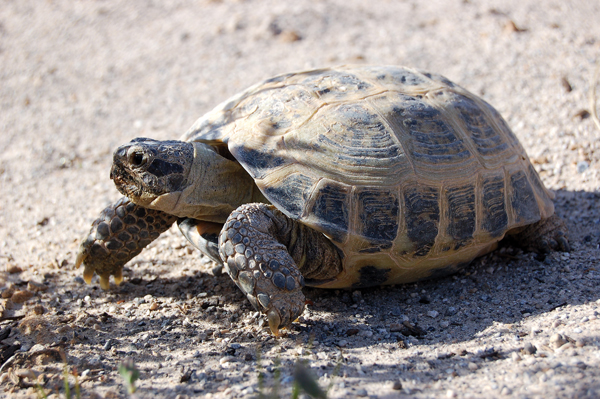
Sarah and Tyler Stewart
The Russian tortoise is favored by hobbyists partly due to a manageable adult size of between 6 to 9 inches, depending on the sex of the tortoise.
It is thought that in the wild, Russian tortoises’ activity levels are at their peak for only about three months of the year. They will sometimes spend more than six months hibernating through cold temperatures, and during the peak of the hot season they will dig in and aestivate, often without moving for weeks at a time in order to avoid the extreme heat at the surface. They are most active, therefore, early in the spring, when reproductive efforts take place, followed by a period in the fall when they spend time fattening themselves up prior to the long winter ahead.
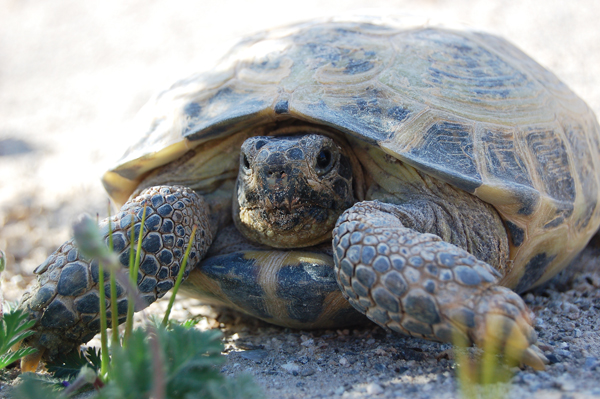
Sarah and Tyler Stewart
Buying wild-caught/imported Russian tortoises can be hit-or-miss, depending, for instance, on how long they were kept at an import facility and the care they received while there.
During winter hibernation, Russian tortoises seem to know how far down they need to burrow in order to remain safely below the “danger zone” in regard to temperatures. We notice ours adjusting and moving around in their outdoor enclosures during the winter, probably in an effort to stay comfortable in the cold temperatures.
Like almost all species of tortoises, A. horsfieldii faces many threats in the wild, including habitat destruction, competition with grazing animals for food, and collection for the pet trade. Fortunately for the Russian tortoise, it has a massive range, so the entire wild population isn’t at risk to the degree many other species with smaller ranges are.
Pet Trade Tortoises
Russian tortoises are imported into the U.S. and many other countries on a regular basis, and have been for many years. The vast majority end up in the big-box pet retailers. Imported Russian tortoises are generally between 4 and 5 inches in length, and usually a mix of sexes. These females are usually two to four well-fed years from being large enough to produce babies.
Imported Russian tortoises also seem to need an adaptation period of a few years once moved to a new area or climate, to get an understanding of the seasons and the availability of food, and to feel comfortable enough to reproduce. If they don’t experience these things, imported Russian tortoises generally won’t settle in and eventually reproduce. We have noticed the same wait period when acquiring tortoises from Florida; they were producing babies in Florida, but once we received them here in Las Vegas they stopped for a few years until they adjusted to the environment.
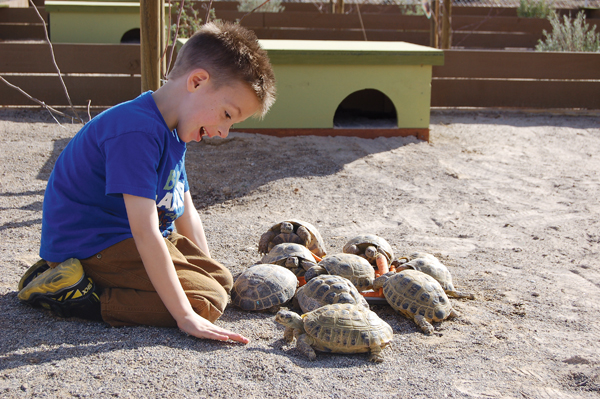
SARAH AND TYLER STEWART
The authors’ son, Mack (also known as the office manager), with some of their Russian tortoises. Note the hide box in the background.
Buying an imported, wild-caught Russian tortoise can be hit or miss. In our experience, if you can get them immediately after import they are in good shape and usually do very well. If they spend any significant amount of time at an importer’s facility, however, particularly one in a humid climate, Russian tortoises tend to deteriorate rather quickly and can be more complicated to establish in a home collection. The same holds true with some pet stores; unless they are getting great care, the longer the tortoises are there, sometimes the worse off they are. When we buy imported Russians, we buy them as soon as they arrive in the U.S. and immediately house them outdoors in our hot/dry climate, which helps them to transition in a stress-free way.
Captive-Bred Russian Tortoises
The small clutch size of Russian tortoises can make it difficult to produce enough to meet the demand for pet Russians. Usually, two to four eggs are laid a few times a year. Our Russians usually come out of hibernation in late February and waste no time in getting very active and frisky almost immediately. We begin getting eggs in March, and babies are usually hatching 60 to 65 days later. We’ll often miss nests in the outdoor enclosures, but the babies have a very good hatch rate out of the ground here in Las Vegas, and we will often see a second wave of babies in late August and early September.
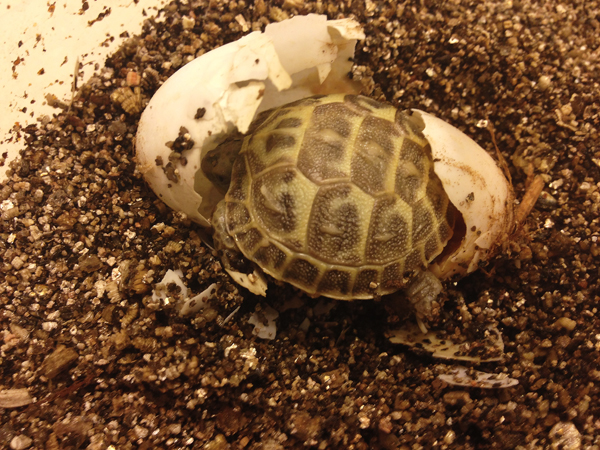
Sarah and Tyler Stewart
The small clutch size of Russian tortoises can make it difficult to produce enough to meet the demand for pet Russians.
Occasionally our Russian tortoises will lay a single clutch in the fall that will hatch on a warm winter day, or sometimes in the spring after over-wintering in the ground. Eggs don’t develop in cold temperatures, but they don’t necessarily die, either. Once it warms back up, most of them resume development where they left off. Because of all these variables, we can potentially get baby Russian tortoises during almost any season of the year. That said, the bulk of them hatch between June and September.
Russian Tortoise Housing
Russian tortoises are often bought as a first pet tortoise by inexperienced hobbyists who intend to keep them indoors. Russians are very forgiving tortoises, and their relatively low cost, ready availability and hardiness makes A. horsfieldii an attractive tortoise to new keepers looking to get their feet wet. However, while keeping them indoors can be done properly, there are some key things to keep in mind.
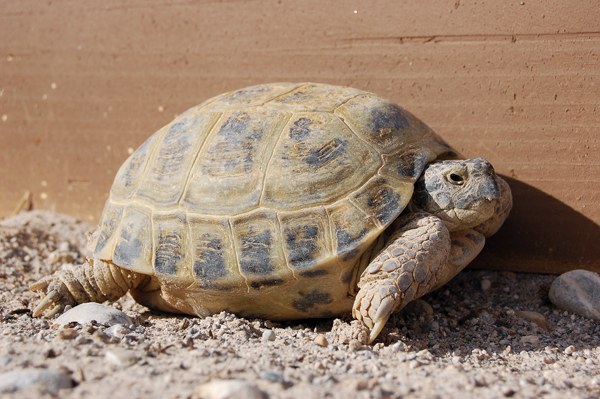
SARAH AND TYLER STEWART
A single adult Russian tortoise should have an enclosure that is at least 2 feet wide by 3 feet long, but always provide as large an enclosure as possible.
For a very basic setup, many people use large, plastic, concrete mixing tubs, which are available at hardware stores, or under-bed plastic sweater boxes that are widely available. You want the footprint to be as large as possible. Ideally, a single adult Russian tortoise that’s 4 inches or larger should have an enclosure that is at least 2 by 3 feet. If the enclosure is any smaller than this, the tortoise will spend the majority of its day trying to escape.
Russian Tortoise Substrate
We don’t recommend sand as a substrate for indoor Russian tortoises. It remains loose, sticks to food items and gets eaten, and it can be a major irritant to a tortoise’s eyes.
Some keepers use sand because the tortoises live on sand or dirt in the wild. But in the wild, the substrate is hard packed and weathered, not loose and sandy. Wild Russian tortoises also graze on low-growing vegetation; they don’t eat directly off the substrate as they often do in captivity. Sand and gravel impaction kills many pet tortoises, usually when they’re living on loose sand or dirt indoors. We have never had impaction problems with cypress mulch or the coco coir we use with our babies.
The walls of the enclosure don’t need to be tall; 8 to 10 inches will usually contain a Russian tortoise. If you are going to be sunning your tortoise outside, you may want a slightly taller enclosure to be on the safe side, if an escape would mean losing your tortoise.
Our favorite substrate is cypress mulch. It’s commonly available, retains moisture or dryness well, isn’t very dusty and provides a stable platform while allowing burrowing. For baby Russian tortoises, we prefer coco coir because it’s less dusty; sometimes peat moss is used, as well. We always maintain some moisture in the babies’ substrate to help keep them from drying out. Babies in the wild spend a huge amount of time underground in cooler, humid burrows and microclimates.
Indoor Russian tortoises need intense lights to maintain an active lifestyle. Dark cages lead to depressed and inactive tortoises. Our favorite light bulbs are Zoo Med’s Powersun mercury vapor bulbs, which are all-in-one bulbs that provide the necessary heat, light and UVB via a single bulb. Lights can also be arranged with tube UVB lights and a separate heat light, but we like the simplicity of a single bulb that does it all. For UVB using the latter method, our preference is the Zoo Med 10.0 UVB bulbs; we typically run twin 48-inch bulbs over two or three enclosures placed side by side.
Russian tortoises don’t need a heat source at night as long as they are heated properly during the day. We generally recommend that the hottest part of an indoor enclosure be around 95 to 100 degrees Fahrenheit directly under the basking bulb. Consider placing a rock about the size of the tortoise you intend to house under the basking bulb, and let it “max out” temperature-wise. Then use a temp gun to measure the surface temperature of the rock. It’s often much hotter than the surface just 2 inches below it, and you want the tortoise, not the substrate, to max out around 100 degrees. Babies are best kept between 90 and 95 degrees, as they dry out faster and don’t really need to be as hot as the adults.
The hottest part of the enclosure should be limited to about 10 to 20 percent of the square footage in the enclosure, and the rest of the enclosure should taper down to room temperature. All heat and lights should be off at night, as a day/night light and temperature cycle is important for tortoises and helps them establish natural patterns.
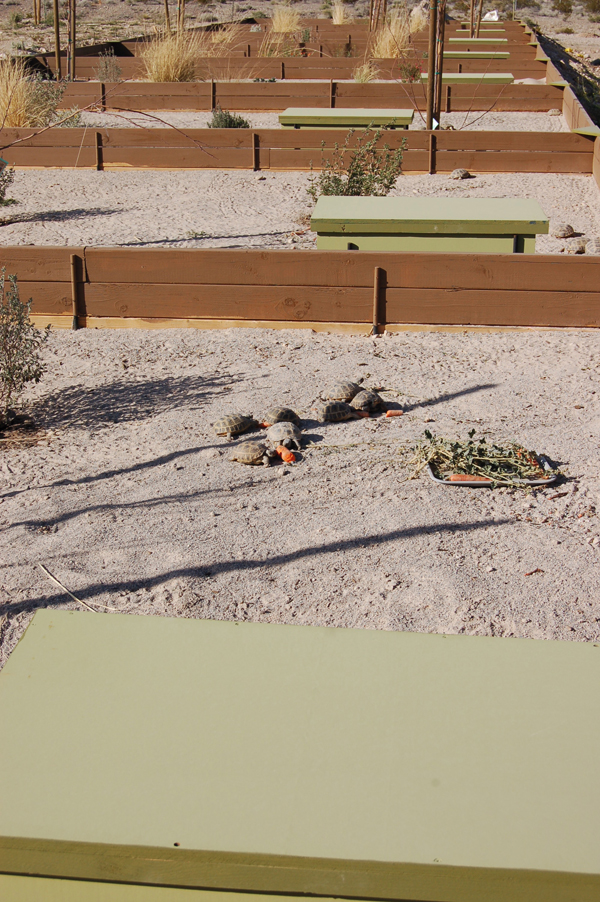
SARAH AND TYLER STEWART
While Russian tortoises can be kept indoors, if you live in an area where the climate permits it, keep them outdoors in a proper tortoise pen.
Cage furniture can be minimal. We provide all indoor tortoises with at least one hide area if not two (one in the cooler part and one in the warm area of the enclosure). For food dishes, we use paper plates because they are easy to swap out rather than having to scrub and clean out ceramic dishes. Water bowls can be used, but we prefer to soak the tortoises regularly instead; it’s less work than maintaining a clean dish in the cage, and you are able to “force hydrate” with manual soakings.
A large, flat rock or two in the indoor enclosure will help maintain healthy toenail length as tortoises walk on it, and if used as a food platter, the rock will help maintain healthy tortoise beaks, also.
Russian Tortoise Outdoor Pens: Preferred If Possible
We are fortunate to live in Las Vegas, and we house our Russian tortoises outdoors year-round with very little maintenance. Outdoor temperatures range from a low of about 20 degrees up to 115 during an average summer.
In a dry climate, wood works very well when constructing outdoor tortoise pens. Our Russian tortoise pens are built with stained 2 x 6 and 2 x 12-inch lumber. The walls generally extend 12 to 16 inches above ground, with 6 inches buried below ground because Russians can be diggers. They will occasionally dig in a corner, but if you place a large flat rock there and cover it with substrate, they will quickly give up, at least in that corner. Cap all the corners with an overhang because corners are where essentially all escape attempts are made. Taller walls can be used for better containment, but if they’re too tall they become obstructive for viewing and less conducive to airflow/temperature control; in a deeper pen, the temperature can stagnate.
We prefer pens that are at least 5 x 8 feet. In any smaller enclosures, we have a hard time getting the temperature gradients that we want, with the sunny areas versus the shade, the dry versus the damp, etc. We shade our enclosures with mesquite trees; they drop their leaves in the winter, letting more sun through, and grow a shade canopy during the warmer months. They are also easy to shape and prune, so you can keep part of the enclosure in full sun and other areas shaded or with broken shade during the summer.
We build wooden hide boxes with a small door for every enclosure, to provide the tortoises a place to retreat from the sun. We like the entrances as small or tight as possible to prevent drafts inside the hide box. This is also where they hibernate through the winter. The boxes don’t need to be large, just enough for each tortoise to fit and then maybe 50 percent more space so they can arrange themselves within it. We include a 6-inch layer of cypress mulch for burrowing and hibernating.
During the summer the hide boxes are in the shade under a tree, which helps keep the interior cooler. During the winter they are placed in full sun most of the day, so they don’t get too cold at night as the substrate within the box warms up a bit during the day.
Visit a local nursery to find live plants that will do well in your climate, then go home and research them to see if they are non-toxic and tortoise-appropriate. For several years we bought plants, often online, that we thought would work, only to have to fight to keep them alive. Then we got smart and began buying with our climate in mind. We now use many types of sage, pampas grass, yellow iris grass and deer grass (mostly for shade, as our Russian tortoises don’t eat the clump grasses too much), cassia, morning glory, prickly pear and globe mallow, which is a native plant we can dig up on our property and transfer to the tortoise pens. All these plants have extremely low water requirements once established.
In addition to the plants, we have some boulders and other naturalistic objects in the pens, and rolling hills with varying elevations.
Feeding Russian Tortoises
Many people think lettuce is all they need to feed their tortoises, and misshapen tortoises can eventually be the result. While greens such as romaine lettuce aren’t necessarily a bad thing, they aren’t a great staple diet, especially for growing young tortoises.
Tortoises in the wild eat a large variety of foods. We sometimes joke that their natural diet is the nutritional equivalent of cardboard, but in reality, it’s only slightly better. They make up for the lack of nutrition in their diet by eating this and that, all day long. Their goal in life is to wake up, search for new food items, maybe check out a female if it’s April or May, search for more food, and then go to bed.
In captivity, Russian tortoises are usually offered foods that are about 100 times richer than what is natural for them, and it’s usually offered once a day in a heaping pile. The ideal diet, though, is dry, rough, bland and high in fiber and calcium.
A spring mix containing greens, such as the pre-packaged bags available in grocery stores, is a good basic diet for Russian tortoises. It provides a good variety of foods, but a more ideal diet would also include leafy weeds like dandelion, plantain and mallow, and leaves such as mulberry, grape, hibiscus and pumpkin/squash leaves. Adding at least some of these additional items to the spring mix will do great things for your tortoises, and the additional roughage will help keep them healthy.
We also offer our Russians a lot of fresh veggies such as bell pepper, squash, almost any leafy green, prickly pear cactus pads, carrots, clovers and many other items. We stash leftover, uncarved Halloween pumpkins until spring—they remain intact and don’t rot in our cool garage—when we break them apart for tortoise food.
For smaller tortoises, we usually put harder items such as pumpkin, squash, etc., into a food processor to dice them into bite-sized pieces. Larger tortoises can be offered hard veggies as-is, and we believe their having to chew at such items builds their strength and is good for their beaks. We joke that soft foods on a silver platter result in sissy tortoises!
Some foods should be avoided, including all fruits, as their sugar can cause indigestion and can also boost parasite loads if present (and they almost always are in wild-caught tortoises). Also avoid cabbage, broccoli and spinach, as these may interfere with a tortoise’s ability to absorb calcium. Avoid iceberg lettuce, too, because it’s not nutritious and little more than water. We aim for dry, coarse greens, and not too much “soft stuff,” which can make tortoise stools runny and contribute to possible dehydration.
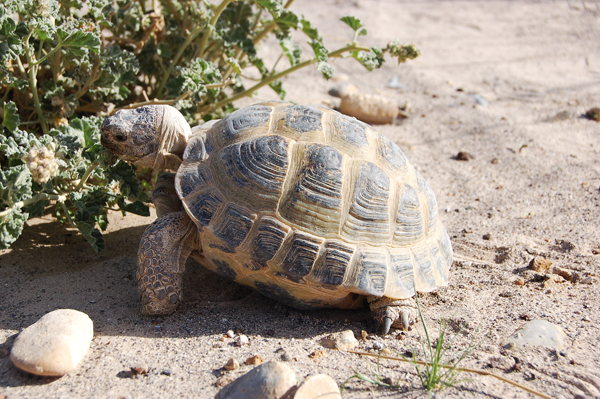
Sarah and Tyler Stewart
The ideal diet for Russian tortoises is dry, rough, bland and high in fiber and calcium.
With a large enough variety in the diet, the need for supplementation may be questionable, but to cover all the bases we offer indoor baby Russian tortoises a calcium/D3 supplement twice a week and a multivitamin once a week, and about half as much for young adults. Tortoises housed outdoors get calcium (without D3) only a few times a year.
Feed all tortoises on plates, not off the substrate, to lessen the chance of accidental substrate ingestion and impaction.
Russian Tortoise Hydration
Water is very important for all tortoises, but it’s extremely important for baby tortoises. We firmly believe that the biggest killer of baby tortoises is dehydration, because they aren’t getting enough physical water to drink, or they aren’t being provided with a humid microclimate.
Some of the older literature suggests that because they live in a dry area, Russian tortoises have little to no water requirements, and that because it can be 110 degrees in their natural range they need to be kept at a near-constant 110 degrees. In reality, they are long gone to shelter by the time the temperature reaches 90 degrees outside during the day, and I can assure you that a Russian tortoise kept at 110 degrees with no water wouldn’t last long. A baby maintained under such conditions would be dead within a few hours. Heat dries them out quickly, particularly babies, so while they can tolerate heat for some time, they need water to drink and via humidity to prevent dehydration.
All of our baby tortoises are raised on substrate containing some level of moisture, and all have access to hide boxes containing high humidity that’s over 80 percent. Babies of all tortoise species should be soaked in shallow, warm water for a half hour at least three to four times a week. Soaking them daily is even better. With adults it’s much less critical, as their shells have hardened and their skin has thickened, making them more efficient at conserving water within their bodies.
Russian tortoises make great pets for both new and experienced tortoise keepers. In our large collection, no other tortoises are as eager to see us as the Russians. They are very food-motivated and fun, eager, active tortoises. Their small size and wide temperature tolerances make them easy to keep in a large variety of climates and situations.
Tyler and Sarah Stewart are tortoise breeders living in Las Vegas Nev., with their four sons. They maintain about 300 adult tortoises of almost all species, from desert to tropical animals. They sell baby tortoises and supplies at their website, www.TortoiseSupply.com.



